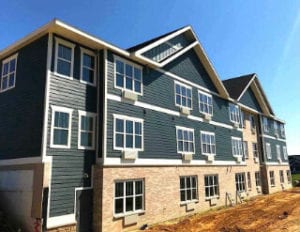In 2017 alone, more than 10.7 million properties were on the receiving end of hail damage. While there are times when hail damage can be severe, it’s essential that you know the signs of hail damage.
With there being various types of roofs used on properties, the signs for each roof will differ. We’ve done the research for you and put everything you need to know about roof hail damage depending on the roof you have in one place.
Not only does a damaged roof look strange, but it can also cause other issues internally that you don’t want to deal with.
Don’t stop reading now; you’re going to want to take a closer look and get to the bottom of those extra dings in your roof before they cause significant problems.
Metal Roofing
While this isn’t commonly seen on homes, there are times where the homeowner felt it held more advantages over other types of roofing materials. Metal roofing uses various types of metals to achieve the desired look.
Some of the metals that are used when installing a metal roof include:
- Copper
- Steel
- Aluminum
One reason that you might have selected it for your home is due to the durability factor. It will last longer and require less maintenance than other types of roofing materials. However, although it is durable, there are some key indicators that your roof has taken a beating from a couple of hailstones.
Hail comes in a variety of shapes and sizes, and it’s because of this that you might be shocked at the effect they leave behind. After a hail storm, some damage left behind might be scratches across the roof.
These scratches cause the material that the roof was coated with to be removed. This makes it very important to contact a professional to come out and make the necessary repairs before the issues become worse.
Another sign of hail damage is denting. Denting can happen when the hail falling speed is at a higher velocity and because of the size of the hail. If you notice these things and they don’t aesthetically affect you, it’s still recommended to have someone look at the roof.
Leaving these things untreated can cause your shingles to deteriorate and cause other problems later on down the line.
Slate Roof
Slate roofs are beautiful to look at and increase the overall aesthetic of your home. Not to mention they are also quite durable and sturdy, but again this doesn’t mean that when the hail is falling, your roof won’t sustain any damage.
Key signs of hail damage to your roof will include broken tiles. Even if the entire tile doesn’t break, you might still notice variations of fractures and holes in the tiles’ material.
These missing pieces of tile could expose the underside of your roof and allow for water to penetrate these areas if it’s not taken care of. A weak point in your roof could lead to problems that would cause you to have to fix more than just a couple of missing tiles, like a leaky roof.
Asphalt Roof
This is going to be the most common type of roofing seen on homes across the world. People enjoy this type of roofing because it fits with any aesthetic, and you don’t have to worry about it wearing down quickly.
However, the downside to asphalt roofing is that it takes quite a beating from the elements that it’s exposed to. The first sign of hail damage is the denting of your metal flashing.
Metal flashing is responsible for directing water away from places that it could settle on your roof. When water settles on the roof and has no place to go, it can cause weak points where water will eventually leak through.
Your roofing might also have dents and pockets left in the shingles as a result of where the hail made contact with the roof during the storm. Hail has also been known to create various cracks in shingles, and depending on the velocity that the hail was traveling can even knock some shingles loose.
One thing that owners are made aware of when it comes to asphalt roofs is that when they notice there is damage to the shingles, it needs immediate attention. When you leave dented or broken shingles in place, it allows these areas to become water containers.
Over time the water will soften that area of your roof, leading to a leak or other water damage in your ceiling. While the damage may not seem like a big deal at the time, we recommend getting the issue taken care of as soon as possible.
Hail Damage: Protecting Your Roof Against the Storm
Hail damage can cause homeowners a lot of frustration when they didn’t see the storm coming, leading to roof damage. But, if you’ve taken the time to check out our guide, you’ll have a better understanding of the signs of damage that your roof has taken.
Remember that depending on the type of roof you have, the damage you see could change in significance and appearance. If you’re searching for someone in your area with the experience to take care of all your hail damage issues, contact us here at Heins Contracting.
Not only do we handle roofing projects, but we can also help you out when it comes to siding services, window services, and your decking needs. We’re waiting on your call to set up your appointment.




